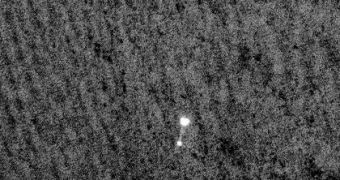On the evening of May 25, the Phoenix Mars Lander successfully touched down in the northern regions of the Red Planet. As it descended to the surface of Mars, the High Resolution Imaging Science Experiment on board NASA's Mars Reconnaissance Orbiter - monitoring the progress of the Phoenix spacecraft - captured this superb image of the lander during its final descent stages, as it was still attached to it parachute. This is the first time when a spacecraft in the orbit of Mars photographs another one while landing.
In the meantime, researchers from the University of Arizona and NASA have published the first images of the Martian surface taken by Phoenix after the landing, and are reporting that the health status of the spacecraft is good in the outcome of the first 24 hours since its arrival.
"We can see cracks in the troughs that make us think the ice is still modifying the surface. We see fresh cracks. Cracks can't be old. They would fill in", said Phoenix Principal Investigator Peter Smith from the University of Arizona.
In order to produce the image seen here, the HiRISE instrument had to be coordinated by Mars Reconnaissance Orbiter with the information regarding its descent trajectory, thus neither the HiRISE nor the Phoenix teams knew whether or not the attempt to photograph it was successful until the image was relayed back to Earth.
"We saw a few other bright spots in the image first, but when we saw the parachute and the lander with the cords connecting them, there was no question", said HiRISE Principal Investigator Alfred McEwen from the University of Arizona.
"I'm floored. I'm absolutely floored", said Phoenix Project Manager Barry Goldstein of NASA's Jet Propulsion Laboratory.
The HiRISE instrument usually makes investigations while pointing directly at the surface of Mars, so for this photograph it had to be tilted at an angle of 62 degrees, meaning that the whole Mars Reconnaissance Orbiter had to be tilted. "We've never taken an image at such an oblique angle before", said McEwen.
The MRO is orbiting Mars at an altitude of 760 kilometers above surface and captured the image of Phoenix shortly after it released its parachute. The 10 meter wide parachute is the upper, larger object while the Phoenix lander clearly appears attached below it. The surrounding black is in fact the picture of Mars' surface in full day, but appears so due to the high contrast between it and the lander.
The parachute was deployed while the spacecraft was at an altitude of 1.6 kilometers, traveling at 1.7 times the speed of sound. Phoenix has scheduled for today a series of diagnoses to make sure that all its instruments and systems are functioning correctly.

 14 DAY TRIAL //
14 DAY TRIAL //